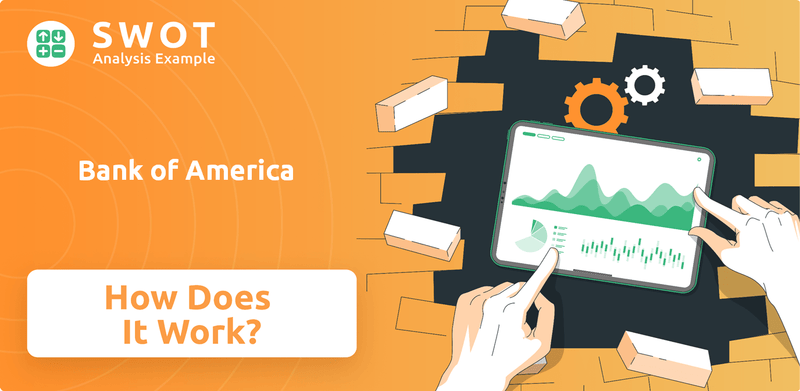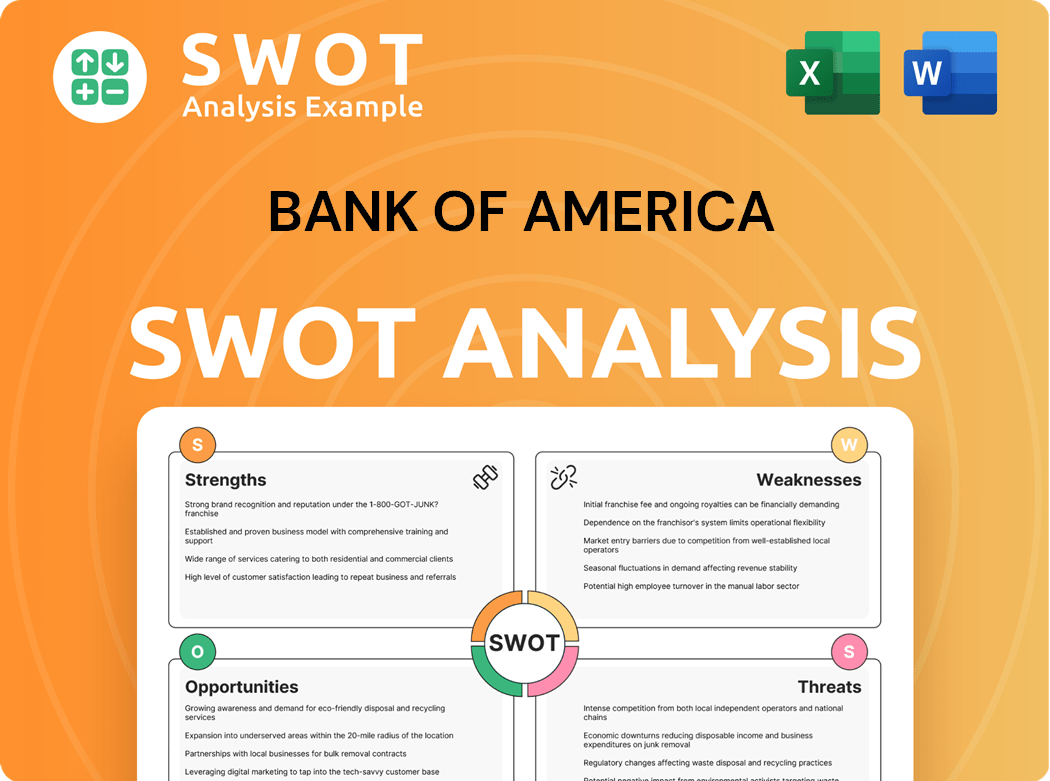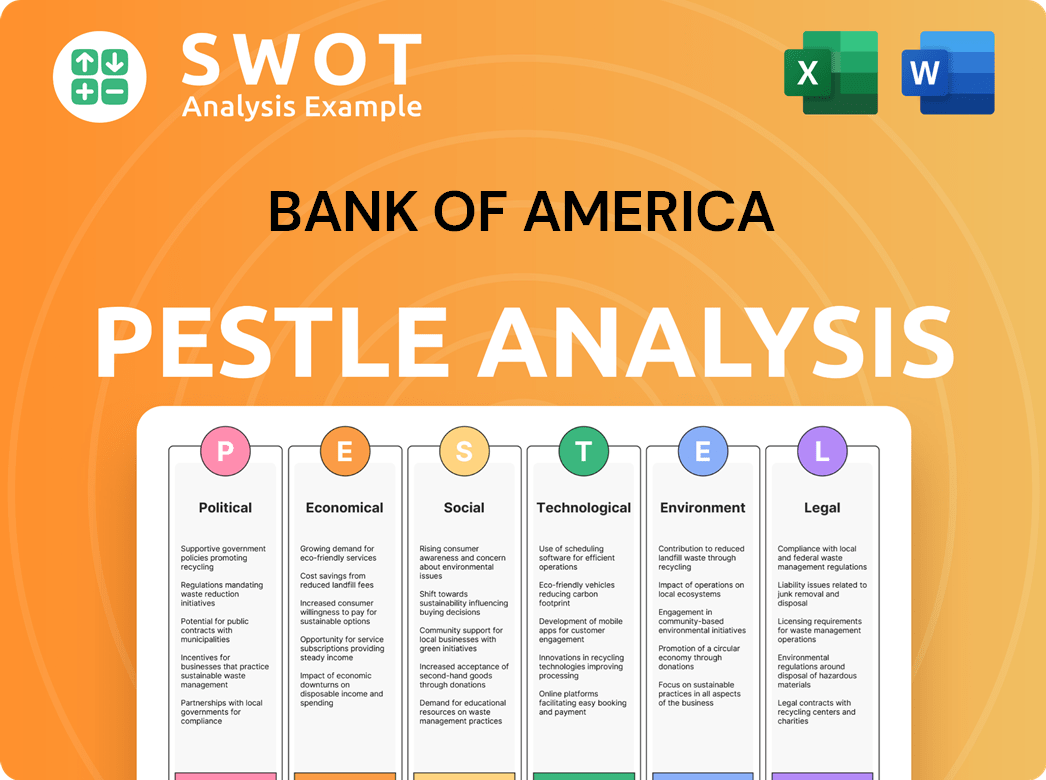Bank of America Bundle
Decoding Bank of America: How Does This Financial Giant Operate?
Bank of America (BOA) stands as a titan in the global financial landscape, but how does this powerhouse truly function? With a reported net income of $7.4 billion in Q1 2025 and total assets nearing $3.2 trillion, understanding Bank of America operations is key for anyone involved in the financial world. From its vast network of retail centers to its diverse financial services, BOA's influence is undeniable.

This exploration into Bank of America's structure will unravel its core operations, revenue streams, and strategic initiatives. Investors seeking to understand the Bank of America SWOT Analysis, customers looking for insights into services, and industry professionals will gain valuable knowledge. Discover how Bank of America makes money and navigates the complex world of banking and financial services.
What Are the Key Operations Driving Bank of America’s Success?
Bank of America, or BOA, operates across four main business segments, delivering a wide array of financial services. These segments include Consumer Banking, Global Wealth & Investment Management, Global Banking, and Global Markets. This structure allows the company to serve a diverse client base, offering everything from basic banking to complex investment solutions.
The value proposition of Bank of America operations lies in its integrated approach and extensive scale. With a balance sheet of approximately $3.3 trillion as of the end of 2024, the bank leverages significant economies of scale. This allows it to offer competitive products and services while investing heavily in technology to improve customer experience and operational efficiency.
Bank of America's commitment to technological advancement is evident in its investments. The company is allocating $4 billion in 2025 towards AI and new tech initiatives. This focus on innovation, combined with its broad service offerings, strengthens its competitive position in the financial services market. You can learn more about the Marketing Strategy of Bank of America.
Consumer Banking provides essential services such as checking and savings accounts, credit cards, and mortgages. This segment is crucial for the bank's deposit base, with the cost of deposits at a favorable 0.64% as of Q4 2024. The bank continues to expand its physical presence.
This segment, including Merrill and the Private Bank, focuses on wealth management for high-net-worth individuals. In Q1 2025, this segment reported broadly flat net income of $1.007 billion, with total client balances reaching $4.157 trillion. The bank's cross-selling efforts added approximately 7,200 net new households in wealth management during Q1 2025.
Global Banking offers lending and advisory services to corporations, while Global Markets provides sales, trading, and research services to institutional clients. In 2024, BOA held a 6.3% market share in investment banking revenue. Global Markets saw a 12% year-over-year increase in revenue, reaching $6.6 billion in Q1 2025.
Bank of America is investing heavily in technology, including AI, to enhance client services and operational efficiency. The AI assistant, Erica, has expanded its capabilities. This investment helps maintain a competitive edge in the rapidly evolving financial landscape.
Here are some key figures illustrating Bank of America's performance and strategy:
- $3.3 trillion: Approximate balance sheet size as of the end of 2024.
- 0.64%: Cost of deposits in Consumer Banking as of Q4 2024.
- $4.157 trillion: Total client balances in Global Wealth & Investment Management in Q1 2025.
- $6.6 billion: Global Markets revenue in Q1 2025.
- $4 billion: Investment in AI and new tech initiatives planned for 2025.
Bank of America SWOT Analysis
- Complete SWOT Breakdown
- Fully Customizable
- Editable in Excel & Word
- Professional Formatting
- Investor-Ready Format

How Does Bank of America Make Money?
Understanding the revenue streams and monetization strategies of Bank of America (BOA) is crucial for grasping its financial health and operational dynamics. The company has demonstrated a robust ability to generate revenue across various financial services, reflecting its extensive reach and diverse offerings. In 2024, the company's revenue exceeded $100 billion, showcasing its strong market position and effective business model.
The primary revenue streams include net interest income, investment and brokerage services, investment banking fees, and global markets operations. These diverse income sources enable Bank of America to maintain financial stability and adapt to market changes. The company's strategic initiatives, such as cross-selling and technological innovation, further enhance its revenue generation and customer engagement.
The bank's revenue streams are diverse, reflecting its comprehensive financial services offerings. In Q1 2025, the bank reported total revenue, net of interest expense, of $27.4 billion, demonstrating its continued financial strength and ability to generate income. This financial performance is supported by a well-balanced mix of revenue sources and strategic initiatives.
Bank of America's revenue model is built on several key pillars. These include net interest income, investment and brokerage services, investment banking fees, and global markets operations. Each stream contributes significantly to the company's overall financial performance, showcasing its diversified business approach. For a broader view of its competitive environment, consider exploring the Competitors Landscape of Bank of America.
- Net Interest Income (NII): This is the income generated from interest-earning assets, minus interest paid on liabilities. Bank of America anticipates NII to reach record highs in 2025, with a projected growth of about 7% in Q4 2025, reaching between $15.5 billion and $15.7 billion. The bank's cost of interest-bearing deposits in its consumer banking division was a low 0.64% in Q4 2024, indicating an advantageous deposit franchise.
- Investment and Brokerage Services: This segment generated $17.77 billion in revenue in fiscal year 2024, representing 37.09% of its total revenue. Asset management fees increased by 15.61% to $13.88 billion in 2024, and brokerage fees rose by 9.27% to $3.89 billion in 2024.
- Investment Banking Fees: This revenue stream increased by 31.39% to $6.19 billion in 2024, including financial advisory services, syndication fees, and underwriting income.
- Global Markets (Sales and Trading): Revenue from this segment was $6.6 billion in Q1 2025, a 12% increase year-over-year. Sales and trading revenue specifically increased by 11% to $5.7 billion in Q1 2025, with equities revenue reaching a record $2.2 billion, up 17%.
Bank of America PESTLE Analysis
- Covers All 6 PESTLE Categories
- No Research Needed – Save Hours of Work
- Built by Experts, Trusted by Consultants
- Instant Download, Ready to Use
- 100% Editable, Fully Customizable

Which Strategic Decisions Have Shaped Bank of America’s Business Model?
Bank of America's journey has been marked by significant strategic moves and key milestones, shaping its current structure and operational capabilities. The acquisition of Merrill Lynch in 2009 for $50 billion stands out as a pivotal moment, diversifying the bank's business model by expanding its wealth and investment banking services. Recent developments include the integration with FedNow in 2023, enhancing transaction speed and transparency, and the ongoing evolution of its digital platforms.
The company has navigated various challenges, including the 2007-2009 financial crisis, which exposed it to the collapsing housing market. In response, Bank of America implemented cost-cutting initiatives like 'Project New BAC' in 2011 to improve operational efficiency. Moreover, the bank resolved legacy liabilities, as seen with the $16.65 billion DOJ settlement in 2014 related to toxic mortgage securities.
Bank of America's competitive edge is built on a foundation of brand strength, a diversified business model, technological leadership, and an extensive network. These elements collectively contribute to its resilience and ability to adapt to market changes. For a deeper understanding of the company's ownership structure, you can explore Owners & Shareholders of Bank of America.
The acquisition of Merrill Lynch in 2009 was a major strategic move. In 2023, the bank integrated with FedNow. The launch of Erica, its AI virtual assistant, in 2018, enhanced the digital client experience.
Cost-cutting initiatives such as 'Project New BAC' in 2011 aimed to boost operational efficiency. The bank settled claims related to toxic mortgage securities in 2014. Continuous investment in technology and digital platforms is ongoing.
Brand strength and scale allow for economies of scale. A diversified business model provides resilience. Technology leadership, including AI and blockchain, is a key focus. An extensive network and digital capabilities enhance customer acquisition.
Bank of America became the first U.S. bank to offer tokenized deposit services in 2025. It is piloting quantum technology in finance through a partnership with IBM in 2024. The bank plans to open 150 new financial centers by 2027.
Bank of America's competitive advantages are rooted in its brand strength and scale, a diversified business model, technology leadership, and a broad network. The bank's assets exceed $3 trillion, allowing for operational efficiency and significant technology investments.
- Brand Strength and Scale: With over $3 trillion in assets, the bank benefits from economies of scale.
- Diversified Business Model: Offers a broad range of financial services across consumer banking, wealth management, and investment banking.
- Technology Leadership: Investing $4 billion in AI and new tech initiatives in 2025. Erica, the AI assistant, is used by over 90% of employees.
- Extensive Network and Digital Capabilities: Continues to expand its physical presence, planning to open 150 new financial centers by 2027.
Bank of America Business Model Canvas
- Complete 9-Block Business Model Canvas
- Effortlessly Communicate Your Business Strategy
- Investor-Ready BMC Format
- 100% Editable and Customizable
- Clear and Structured Layout

How Is Bank of America Positioning Itself for Continued Success?
Bank of America (BOA) maintains a significant position in the financial services industry. As of Q1 2025, it held a market share of 17.77%, ranking as a leading player, though trailing JPMorgan Chase & Co. at 29.00%. Its extensive network and digital capabilities contribute to strong customer loyalty and global reach. Bank of America's growth strategy focuses on leveraging its robust infrastructure and expanding its digital footprint.
Despite its strong market position, Bank of America faces various risks. These include macroeconomic factors, regulatory changes, technological disruption, and credit quality concerns. These factors can impact Bank of America operations and profitability.
Bank of America is a major player in the banking sector. It has a substantial market share and a broad customer base. The bank's wealth management division manages over $4 trillion in client balances. BOA ranks third globally in investment banking revenue, with a 6.3% market share in 2024.
The company faces risks from macroeconomic factors like interest rates, economic growth, and inflation. Regulatory changes and technological advancements also pose challenges. Deterioration in consumer credit quality and challenges in commercial real estate could lead to increased loan losses.
Bank of America is focused on revenue generation through strategic initiatives. The company plans to build a sustainable, digitally empowered financial ecosystem. This includes scaling its technological infrastructure and deepening ESG commitments.
The bank plans to broaden the implementation of decentralized finance technologies. It also plans to continue its physical expansion, adding 150 new financial centers by 2027. BOA projects a full-year net interest income improvement of 6-7%.
Bank of America's future hinges on several critical factors. These include its ability to manage macroeconomic risks and adapt to technological changes. The bank's strategic focus on digital transformation and expansion is crucial for sustained growth.
- Digital Transformation: BOA is investing heavily in digital platforms and services.
- Geographic Expansion: The company is adding new financial centers.
- Decentralized Finance: BOA plans to implement decentralized finance technologies.
- ESG Commitments: Bank of America is deepening its commitments to Environmental, Social, and Governance factors.
Bank of America Porter's Five Forces Analysis
- Covers All 5 Competitive Forces in Detail
- Structured for Consultants, Students, and Founders
- 100% Editable in Microsoft Word & Excel
- Instant Digital Download – Use Immediately
- Compatible with Mac & PC – Fully Unlocked

Related Blogs
- What are Mission Vision & Core Values of Bank of America Company?
- What is Competitive Landscape of Bank of America Company?
- What is Growth Strategy and Future Prospects of Bank of America Company?
- What is Sales and Marketing Strategy of Bank of America Company?
- What is Brief History of Bank of America Company?
- Who Owns Bank of America Company?
- What is Customer Demographics and Target Market of Bank of America Company?
Disclaimer
All information, articles, and product details provided on this website are for general informational and educational purposes only. We do not claim any ownership over, nor do we intend to infringe upon, any trademarks, copyrights, logos, brand names, or other intellectual property mentioned or depicted on this site. Such intellectual property remains the property of its respective owners, and any references here are made solely for identification or informational purposes, without implying any affiliation, endorsement, or partnership.
We make no representations or warranties, express or implied, regarding the accuracy, completeness, or suitability of any content or products presented. Nothing on this website should be construed as legal, tax, investment, financial, medical, or other professional advice. In addition, no part of this site—including articles or product references—constitutes a solicitation, recommendation, endorsement, advertisement, or offer to buy or sell any securities, franchises, or other financial instruments, particularly in jurisdictions where such activity would be unlawful.
All content is of a general nature and may not address the specific circumstances of any individual or entity. It is not a substitute for professional advice or services. Any actions you take based on the information provided here are strictly at your own risk. You accept full responsibility for any decisions or outcomes arising from your use of this website and agree to release us from any liability in connection with your use of, or reliance upon, the content or products found herein.